Attached files
| file | filename |
|---|---|
| 8-K - 8-K - SEELOS THERAPEUTICS, INC. | a8-kforcorppres9x10x14.htm |
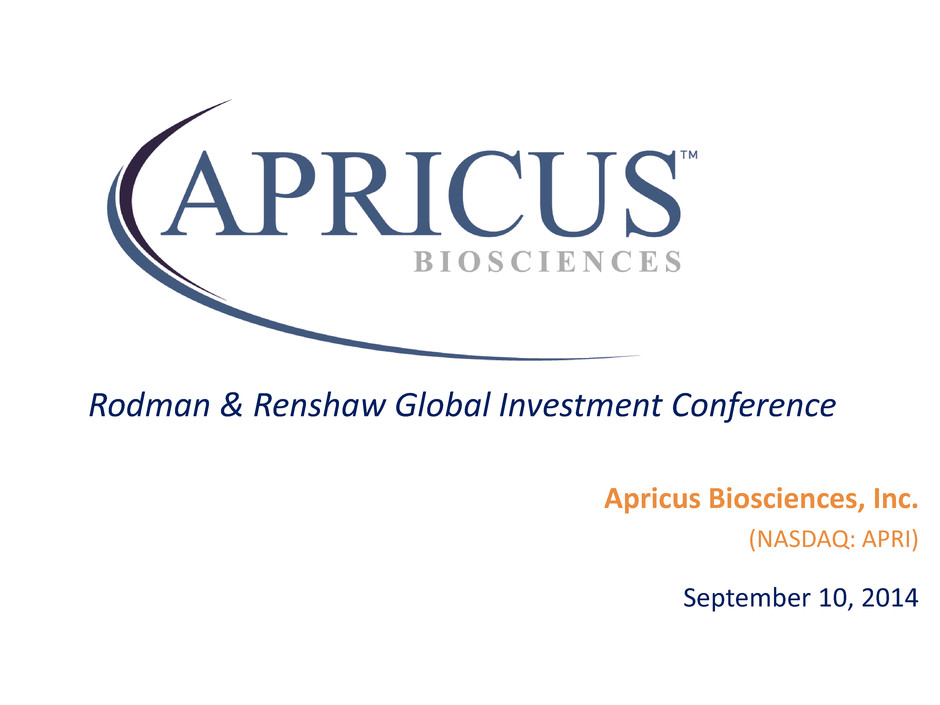
Rodman & Renshaw Global Investment Conference Apricus Biosciences, Inc. (NASDAQ: APRI) September 10, 2014
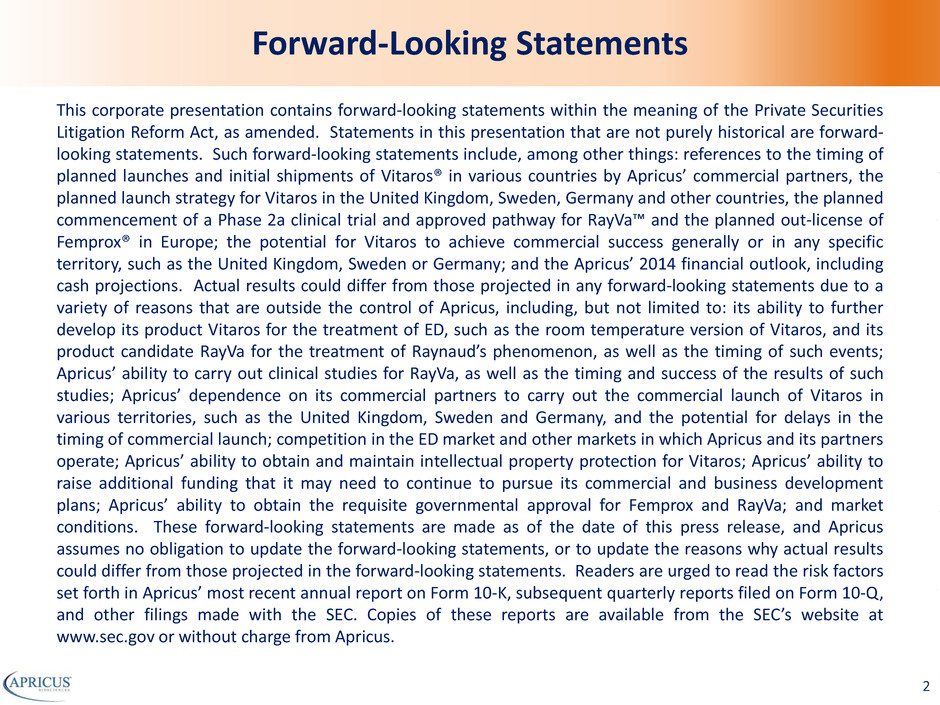
Forward-Looking Statements This corporate presentation contains forward-looking statements within the meaning of the Private Securities Litigation Reform Act, as amended. Statements in this presentation that are not purely historical are forward- looking statements. Such forward-looking statements include, among other things: references to the timing of planned launches and initial shipments of Vitaros® in various countries by Apricus’ commercial partners, the planned launch strategy for Vitaros in the United Kingdom, Sweden, Germany and other countries, the planned commencement of a Phase 2a clinical trial and approved pathway for RayVa™ and the planned out-license of Femprox® in Europe; the potential for Vitaros to achieve commercial success generally or in any specific territory, such as the United Kingdom, Sweden or Germany; and the Apricus’ 2014 financial outlook, including cash projections. Actual results could differ from those projected in any forward-looking statements due to a variety of reasons that are outside the control of Apricus, including, but not limited to: its ability to further develop its product Vitaros for the treatment of ED, such as the room temperature version of Vitaros, and its product candidate RayVa for the treatment of Raynaud’s phenomenon, as well as the timing of such events; Apricus’ ability to carry out clinical studies for RayVa, as well as the timing and success of the results of such studies; Apricus’ dependence on its commercial partners to carry out the commercial launch of Vitaros in various territories, such as the United Kingdom, Sweden and Germany, and the potential for delays in the timing of commercial launch; competition in the ED market and other markets in which Apricus and its partners operate; Apricus’ ability to obtain and maintain intellectual property protection for Vitaros; Apricus’ ability to raise additional funding that it may need to continue to pursue its commercial and business development plans; Apricus’ ability to obtain the requisite governmental approval for Femprox and RayVa; and market conditions. These forward-looking statements are made as of the date of this press release, and Apricus assumes no obligation to update the forward-looking statements, or to update the reasons why actual results could differ from those projected in the forward-looking statements. Readers are urged to read the risk factors set forth in Apricus’ most recent annual report on Form 10-K, subsequent quarterly reports filed on Form 10-Q, and other filings made with the SEC. Copies of these reports are available from the SEC’s website at www.sec.gov or without charge from Apricus. 2
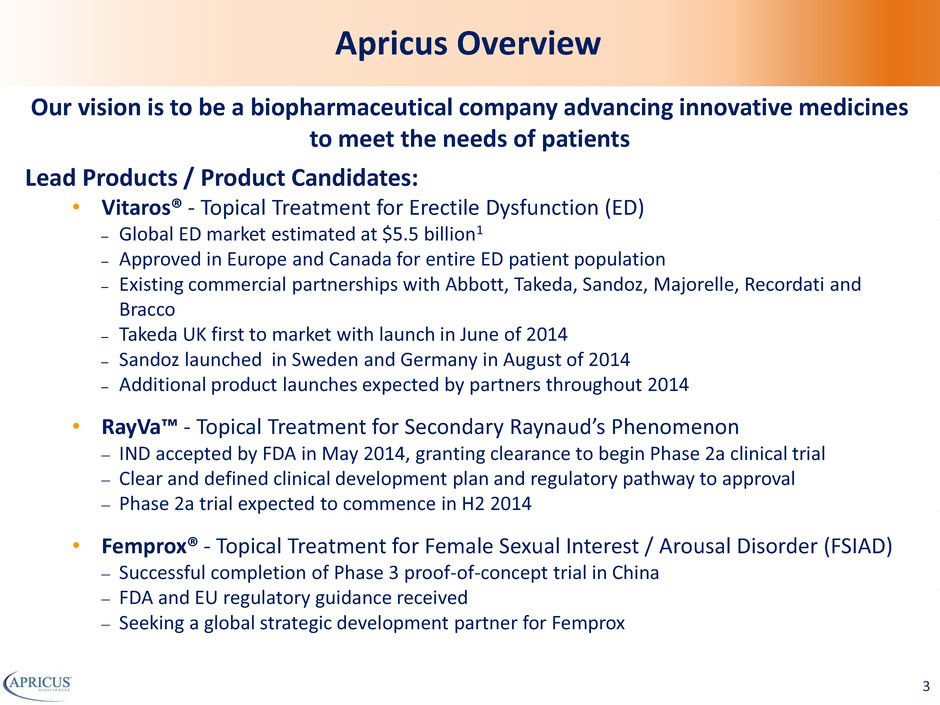
Our vision is to be a biopharmaceutical company advancing innovative medicines to meet the needs of patients Lead Products / Product Candidates: • Vitaros® - Topical Treatment for Erectile Dysfunction (ED) – Global ED market estimated at $5.5 billion1 – Approved in Europe and Canada for entire ED patient population – Existing commercial partnerships with Abbott, Takeda, Sandoz, Majorelle, Recordati and Bracco – Takeda UK first to market with launch in June of 2014 – Sandoz launched in Sweden and Germany in August of 2014 – Additional product launches expected by partners throughout 2014 • RayVa™ - Topical Treatment for Secondary Raynaud’s Phenomenon – IND accepted by FDA in May 2014, granting clearance to begin Phase 2a clinical trial – Clear and defined clinical development plan and regulatory pathway to approval – Phase 2a trial expected to commence in H2 2014 • Femprox® - Topical Treatment for Female Sexual Interest / Arousal Disorder (FSIAD) – Successful completion of Phase 3 proof-of-concept trial in China – FDA and EU regulatory guidance received – Seeking a global strategic development partner for Femprox Apricus Overview 3
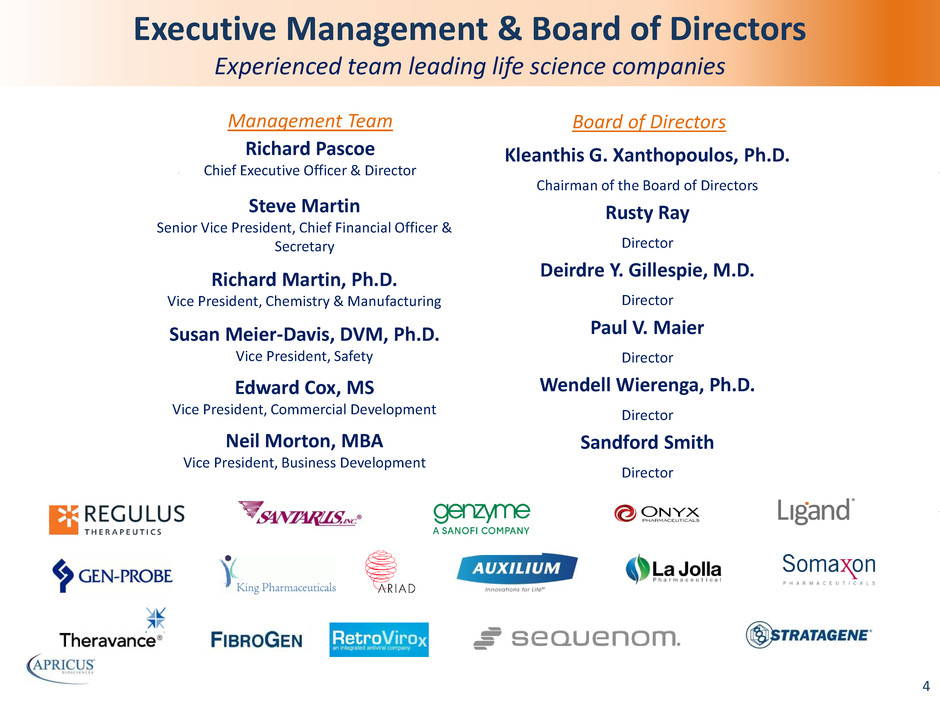
Executive Management & Board of Directors Experienced team leading life science companies Richard Pascoe Chief Executive Officer & Director Steve Martin Senior Vice President, Chief Financial Officer & Secretary Richard Martin, Ph.D. Vice President, Chemistry & Manufacturing Susan Meier-Davis, DVM, Ph.D. Vice President, Safety Edward Cox, MS Vice President, Commercial Development Neil Morton, MBA Vice President, Business Development Kleanthis G. Xanthopoulos, Ph.D. Chairman of the Board of Directors Rusty Ray Director Deirdre Y. Gillespie, M.D. Director Paul V. Maier Director Wendell Wierenga, Ph.D. Director Sandford Smith Director Management Team Board of Directors 4
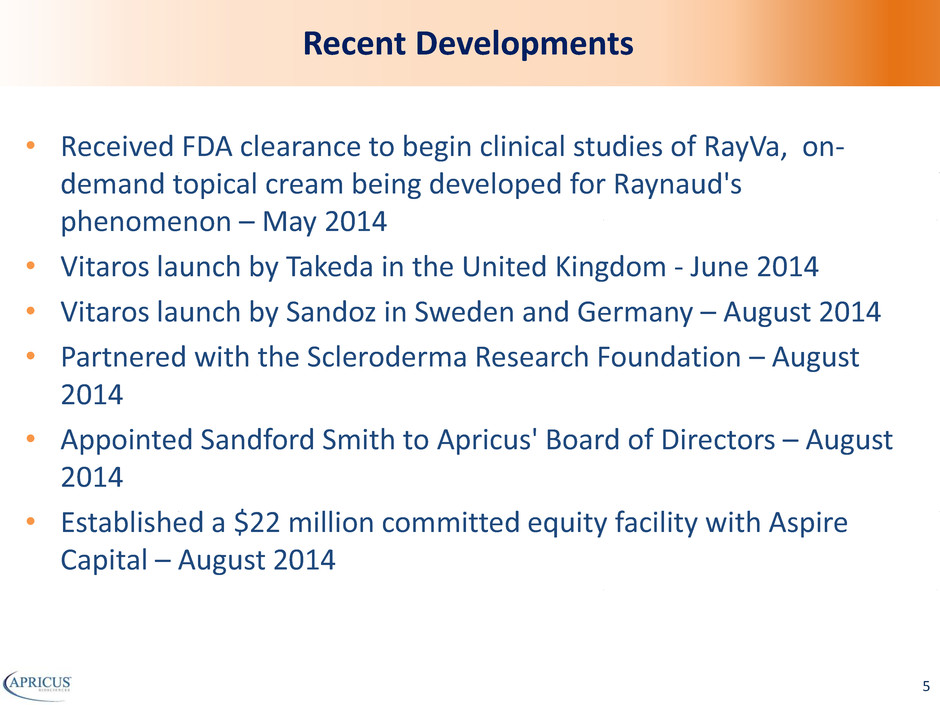
• Received FDA clearance to begin clinical studies of RayVa, on- demand topical cream being developed for Raynaud's phenomenon – May 2014 • Vitaros launch by Takeda in the United Kingdom - June 2014 • Vitaros launch by Sandoz in Sweden and Germany – August 2014 • Partnered with the Scleroderma Research Foundation – August 2014 • Appointed Sandford Smith to Apricus' Board of Directors – August 2014 • Established a $22 million committed equity facility with Aspire Capital – August 2014 Recent Developments 5
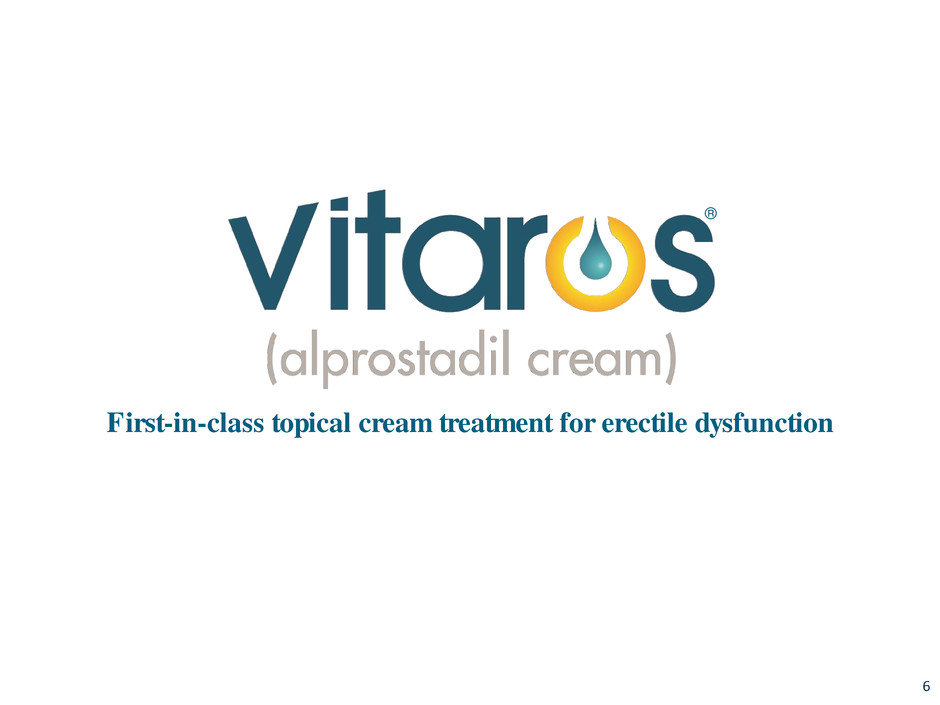
First-in-class topical cream treatment for erectile dysfunction ® 6
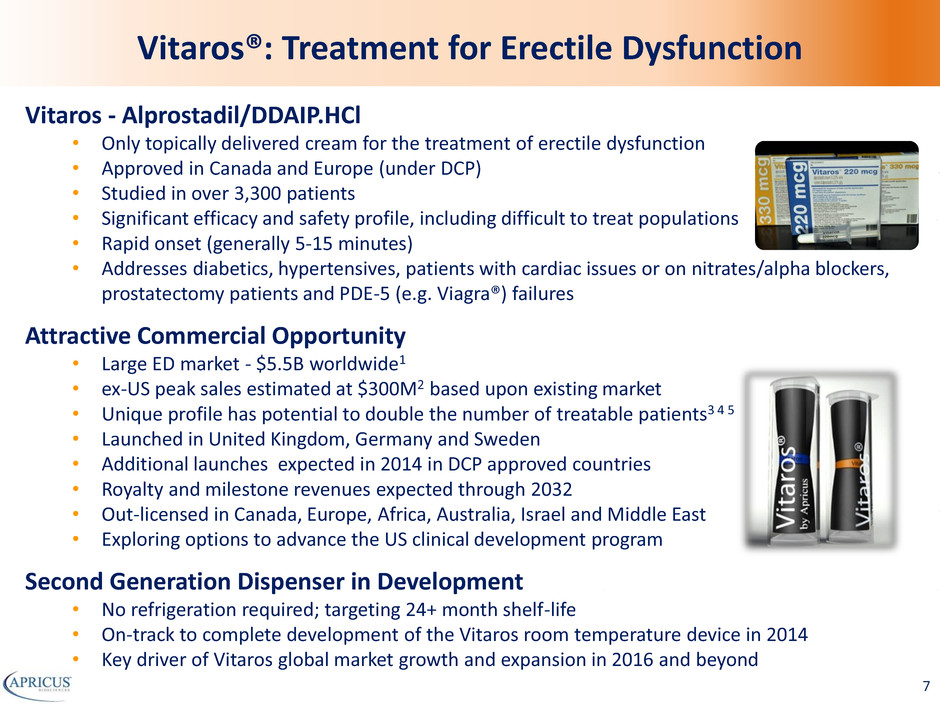
Vitaros - Alprostadil/DDAIP.HCl • Only topically delivered cream for the treatment of erectile dysfunction • Approved in Canada and Europe (under DCP) • Studied in over 3,300 patients • Significant efficacy and safety profile, including difficult to treat populations • Rapid onset (generally 5-15 minutes) • Addresses diabetics, hypertensives, patients with cardiac issues or on nitrates/alpha blockers, prostatectomy patients and PDE-5 (e.g. Viagra®) failures Attractive Commercial Opportunity • Large ED market - $5.5B worldwide1 • ex-US peak sales estimated at $300M2 based upon existing market • Unique profile has potential to double the number of treatable patients3 4 5 • Launched in United Kingdom, Germany and Sweden • Additional launches expected in 2014 in DCP approved countries • Royalty and milestone revenues expected through 2032 • Out-licensed in Canada, Europe, Africa, Australia, Israel and Middle East • Exploring options to advance the US clinical development program Second Generation Dispenser in Development • No refrigeration required; targeting 24+ month shelf-life • On-track to complete development of the Vitaros room temperature device in 2014 • Key driver of Vitaros global market growth and expansion in 2016 and beyond Vitaros®: Treatment for Erectile Dysfunction 7
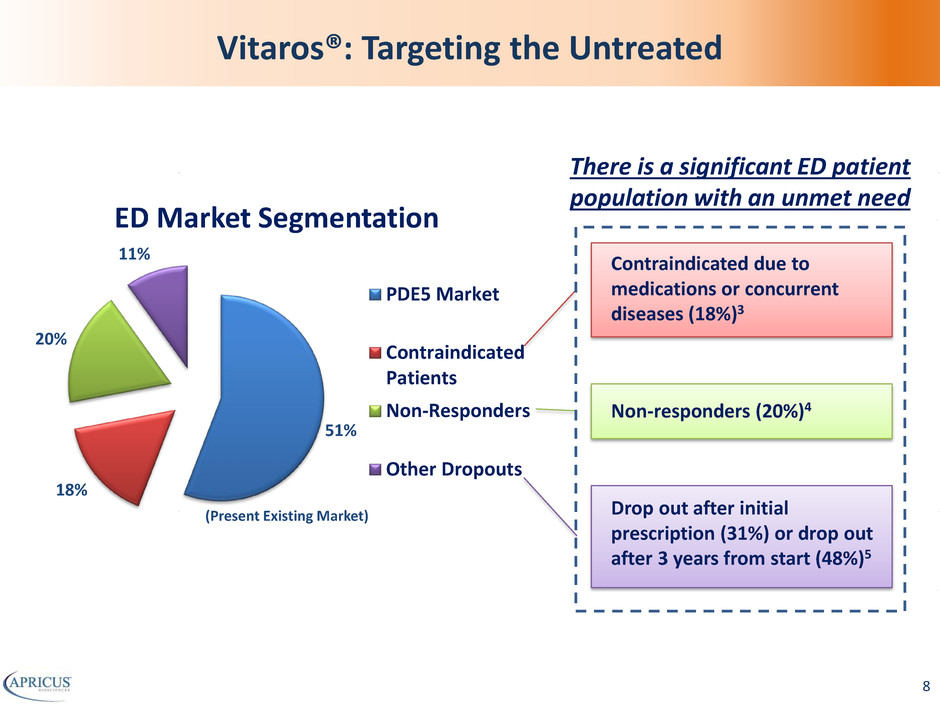
Vitaros®: Targeting the Untreated Contraindicated due to medications or concurrent diseases (18%)3 Non-responders (20%)4 Drop out after initial prescription (31%) or drop out after 3 years from start (48%)5 51% 18% 20% 11% ED Market Segmentation PDE5 Market Contraindicated Patients Non-Responders Other Dropouts (Present Existing Market) There is a significant ED patient population with an unmet need 8
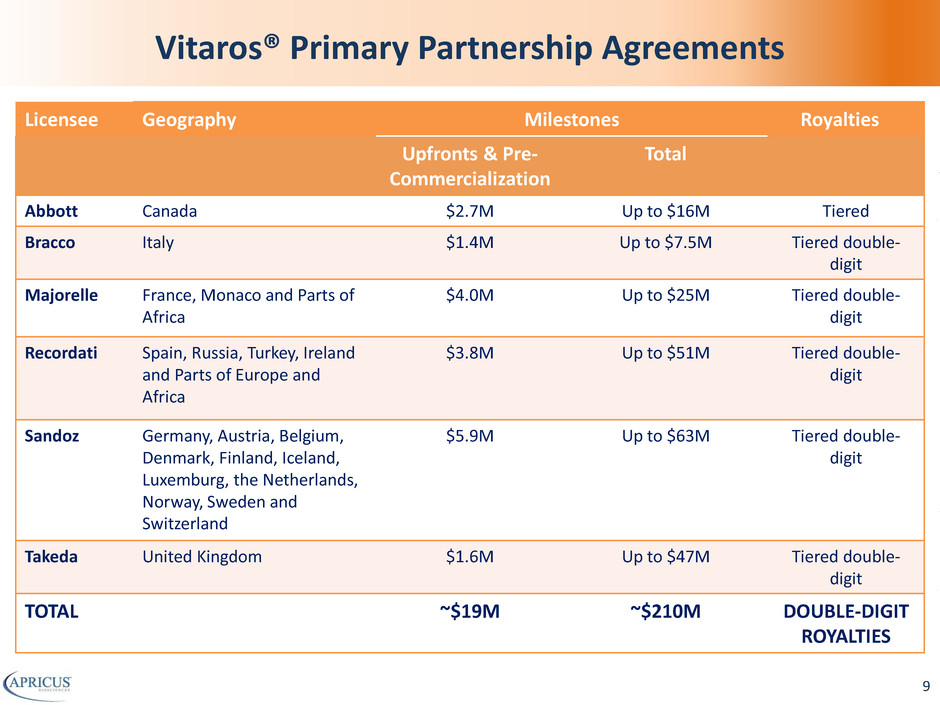
Vitaros® Primary Partnership Agreements Licensee Geography Milestones Royalties Upfronts & Pre- Commercialization Total Abbott Canada $2.7M Up to $16M Tiered Bracco Italy $1.4M Up to $7.5M Tiered double- digit Majorelle France, Monaco and Parts of Africa $4.0M Up to $25M Tiered double- digit Recordati Spain, Russia, Turkey, Ireland and Parts of Europe and Africa $3.8M Up to $51M Tiered double- digit Sandoz Germany, Austria, Belgium, Denmark, Finland, Iceland, Luxemburg, the Netherlands, Norway, Sweden and Switzerland $5.9M Up to $63M Tiered double- digit Takeda United Kingdom $1.6M Up to $47M Tiered double- digit TOTAL ~$19M ~$210M DOUBLE-DIGIT ROYALTIES 9
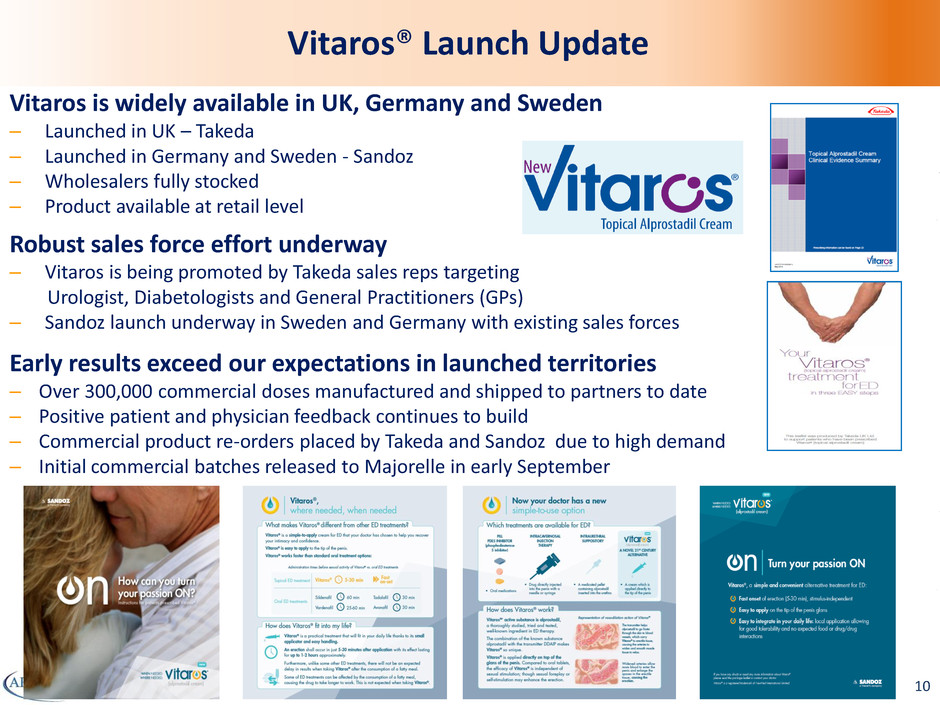
Vitaros is widely available in UK, Germany and Sweden – Launched in UK – Takeda – Launched in Germany and Sweden - Sandoz – Wholesalers fully stocked – Product available at retail level Robust sales force effort underway – Vitaros is being promoted by Takeda sales reps targeting Urologist, Diabetologists and General Practitioners (GPs) – Sandoz launch underway in Sweden and Germany with existing sales forces Early results exceed our expectations in launched territories – Over 300,000 commercial doses manufactured and shipped to partners to date – Positive patient and physician feedback continues to build – Commercial product re-orders placed by Takeda and Sandoz due to high demand – Initial commercial batches released to Majorelle in early September Vitaros® Launch Update 10
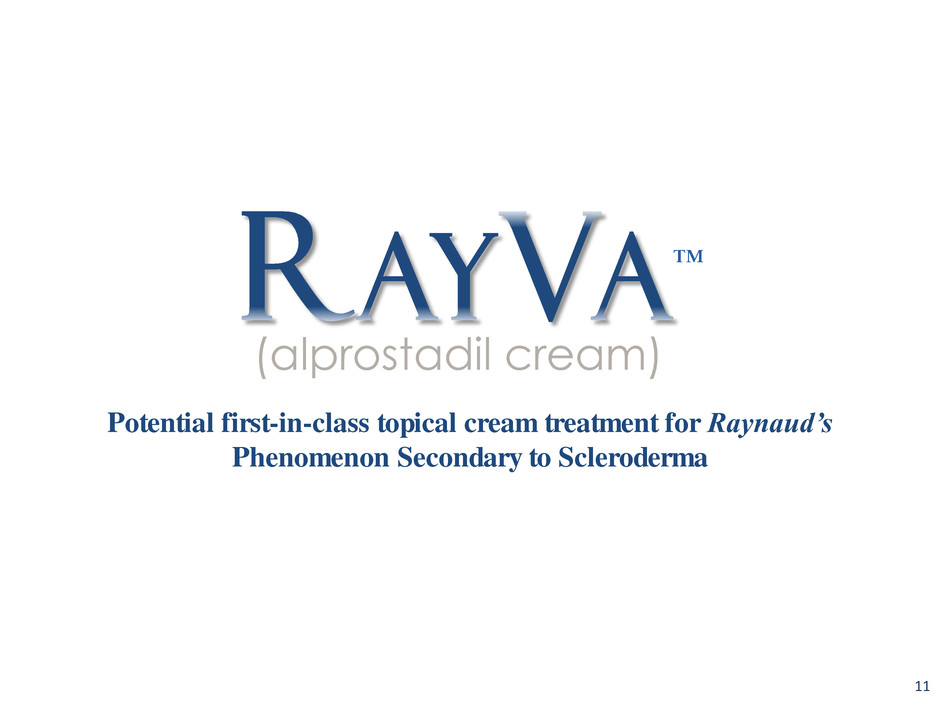
Potential first-in-class topical cream treatment for Raynaud’s Phenomenon Secondary to Scleroderma ™ (alprostadil cream) 11
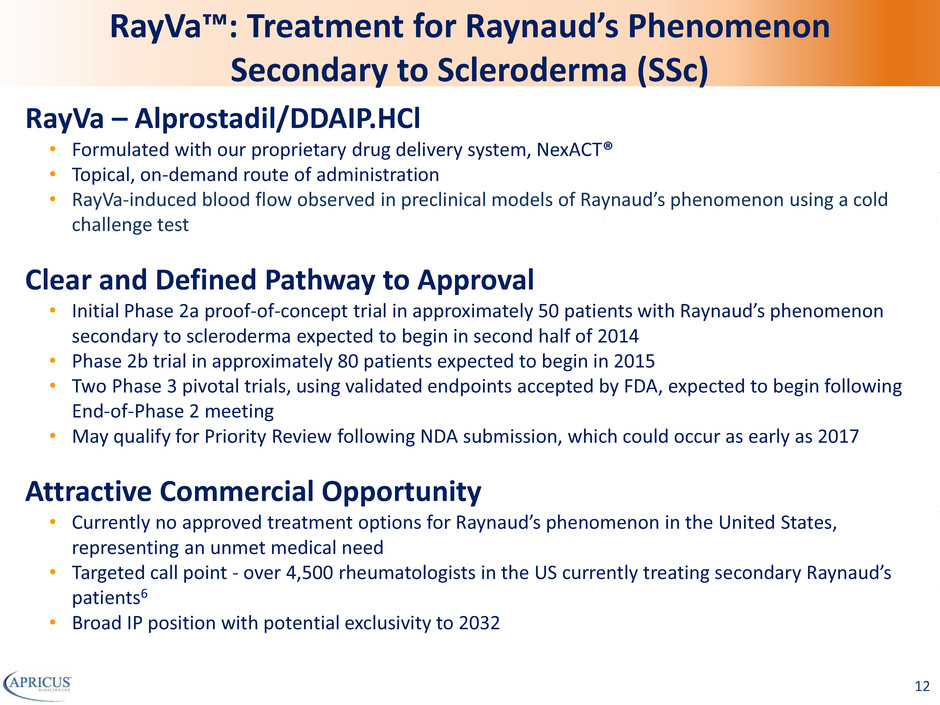
RayVa – Alprostadil/DDAIP.HCl • Formulated with our proprietary drug delivery system, NexACT® • Topical, on-demand route of administration • RayVa-induced blood flow observed in preclinical models of Raynaud’s phenomenon using a cold challenge test Clear and Defined Pathway to Approval • Initial Phase 2a proof-of-concept trial in approximately 50 patients with Raynaud’s phenomenon secondary to scleroderma expected to begin in second half of 2014 • Phase 2b trial in approximately 80 patients expected to begin in 2015 • Two Phase 3 pivotal trials, using validated endpoints accepted by FDA, expected to begin following End-of-Phase 2 meeting • May qualify for Priority Review following NDA submission, which could occur as early as 2017 Attractive Commercial Opportunity • Currently no approved treatment options for Raynaud’s phenomenon in the United States, representing an unmet medical need • Targeted call point - over 4,500 rheumatologists in the US currently treating secondary Raynaud’s patients6 • Broad IP position with potential exclusivity to 2032 RayVa™: Treatment for Raynaud’s Phenomenon Secondary to Scleroderma (SSc) 12
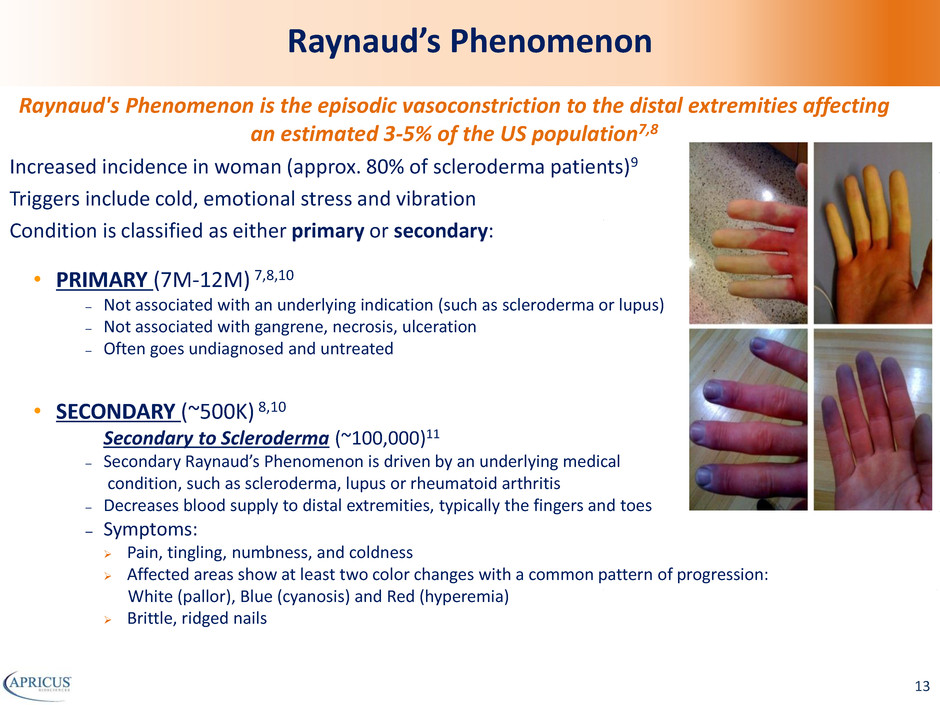
Raynaud’s Phenomenon Raynaud's Phenomenon is the episodic vasoconstriction to the distal extremities affecting an estimated 3-5% of the US population7,8 Increased incidence in woman (approx. 80% of scleroderma patients)9 Triggers include cold, emotional stress and vibration Condition is classified as either primary or secondary: • PRIMARY (7M-12M) 7,8,10 – Not associated with an underlying indication (such as scleroderma or lupus) – Not associated with gangrene, necrosis, ulceration – Often goes undiagnosed and untreated • SECONDARY (~500K) 8,10 Secondary to Scleroderma (~100,000)11 – Secondary Raynaud’s Phenomenon is driven by an underlying medical condition, such as scleroderma, lupus or rheumatoid arthritis – Decreases blood supply to distal extremities, typically the fingers and toes – Symptoms: Pain, tingling, numbness, and coldness Affected areas show at least two color changes with a common pattern of progression: White (pallor), Blue (cyanosis) and Red (hyperemia) Brittle, ridged nails 13
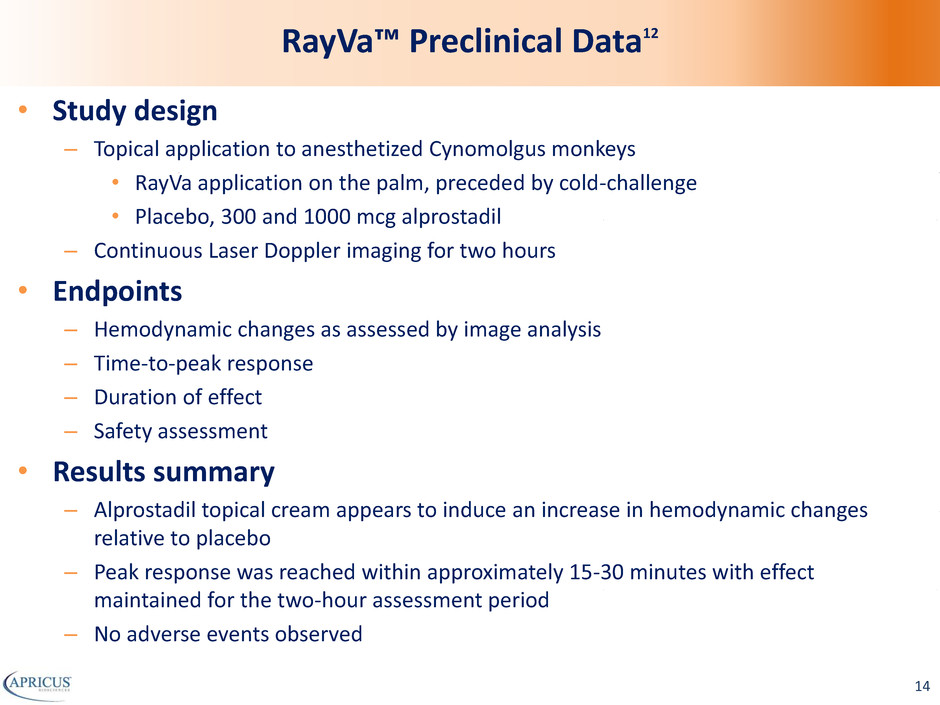
• Study design – Topical application to anesthetized Cynomolgus monkeys • RayVa application on the palm, preceded by cold-challenge • Placebo, 300 and 1000 mcg alprostadil – Continuous Laser Doppler imaging for two hours • Endpoints – Hemodynamic changes as assessed by image analysis – Time-to-peak response – Duration of effect – Safety assessment • Results summary – Alprostadil topical cream appears to induce an increase in hemodynamic changes relative to placebo – Peak response was reached within approximately 15-30 minutes with effect maintained for the two-hour assessment period – No adverse events observed RayVa™ Preclinical Data12 14
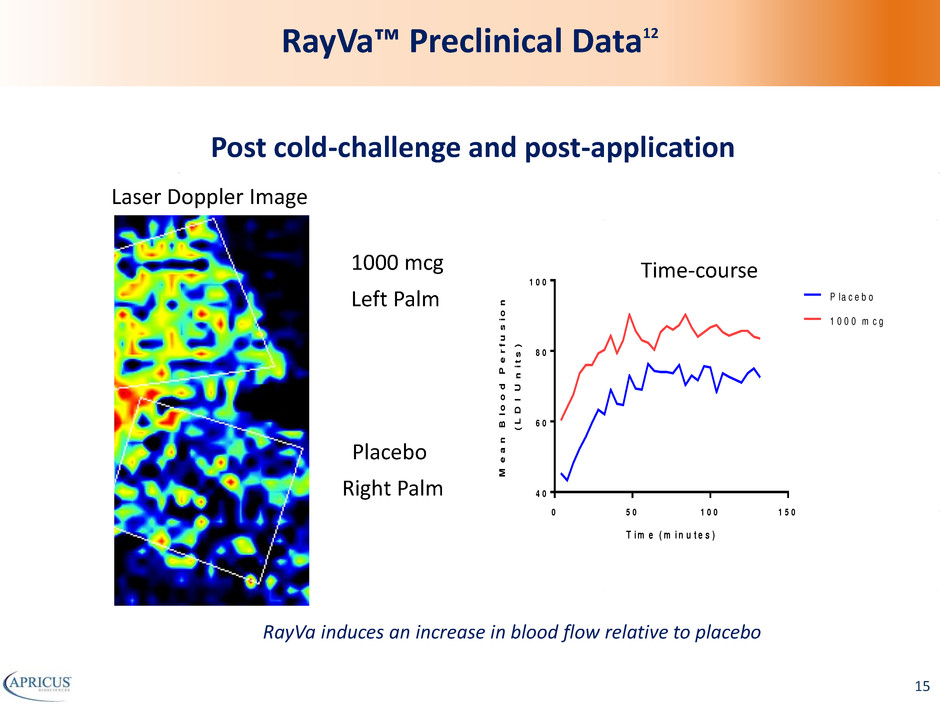
T i m e ( m i n u t e s ) M e a n B lo o d P e rf u s io n (L D I U n it s ) 0 5 0 1 0 0 1 5 0 4 0 6 0 8 0 1 0 0 P l a c e b o 1 0 0 0 m c g Post cold-challenge and post-application 1000 mcg Placebo Laser Doppler Image Time-course Left Palm Right Palm RayVa induces an increase in blood flow relative to placebo RayVa™ Preclinical Data12 15
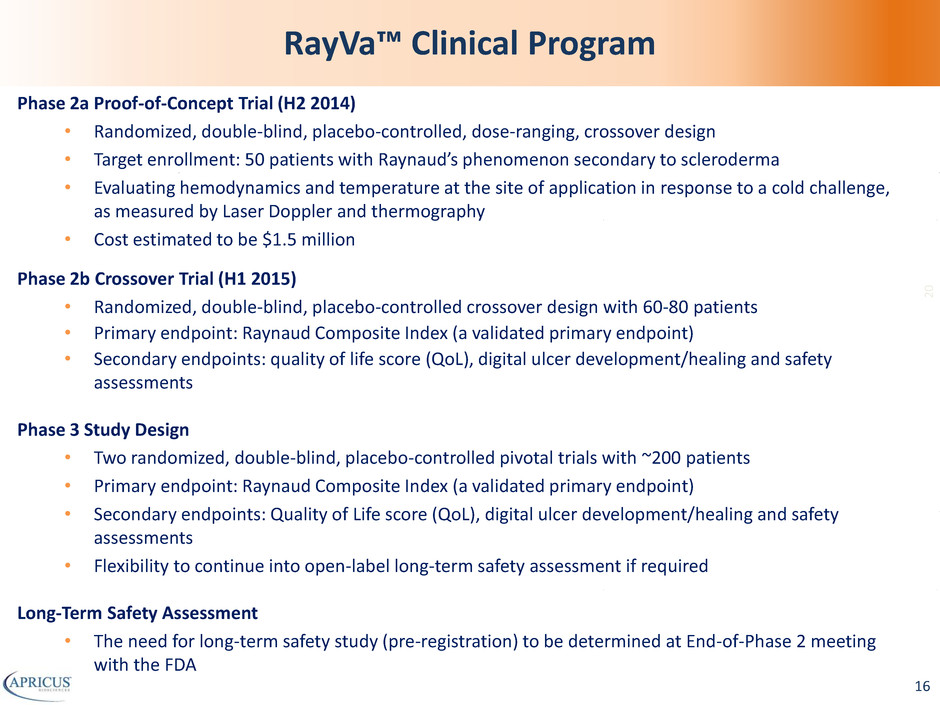
Phase 2a Proof-of-Concept Trial (H2 2014) • Randomized, double-blind, placebo-controlled, dose-ranging, crossover design • Target enrollment: 50 patients with Raynaud’s phenomenon secondary to scleroderma • Evaluating hemodynamics and temperature at the site of application in response to a cold challenge, as measured by Laser Doppler and thermography • Cost estimated to be $1.5 million Phase 2b Crossover Trial (H1 2015) • Randomized, double-blind, placebo-controlled crossover design with 60-80 patients • Primary endpoint: Raynaud Composite Index (a validated primary endpoint) • Secondary endpoints: quality of life score (QoL), digital ulcer development/healing and safety assessments Phase 3 Study Design • Two randomized, double-blind, placebo-controlled pivotal trials with ~200 patients • Primary endpoint: Raynaud Composite Index (a validated primary endpoint) • Secondary endpoints: Quality of Life score (QoL), digital ulcer development/healing and safety assessments • Flexibility to continue into open-label long-term safety assessment if required Long-Term Safety Assessment • The need for long-term safety study (pre-registration) to be determined at End-of-Phase 2 meeting with the FDA 2 0 RayVa™ Clinical Program 16
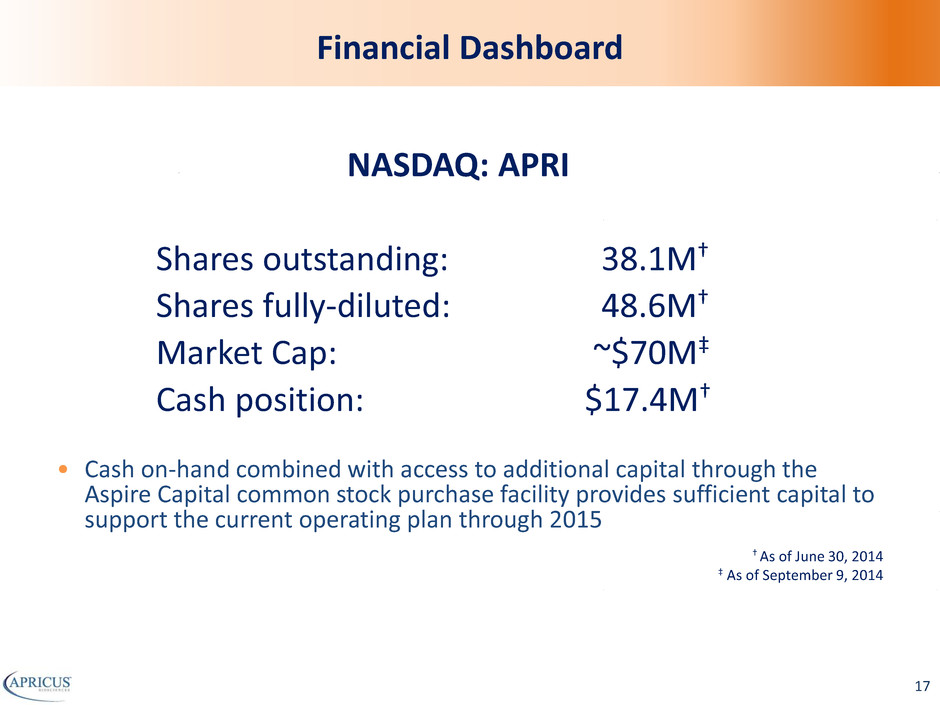
• Cash on-hand combined with access to additional capital through the Aspire Capital common stock purchase facility provides sufficient capital to support the current operating plan through 2015 † As of June 30, 2014 ‡ As of September 9, 2014 Financial Dashboard NASDAQ: APRI Shares outstanding: 38.1M† Shares fully-diluted: 48.6M† Market Cap: ~$70M‡ Cash position: $17.4M† 17
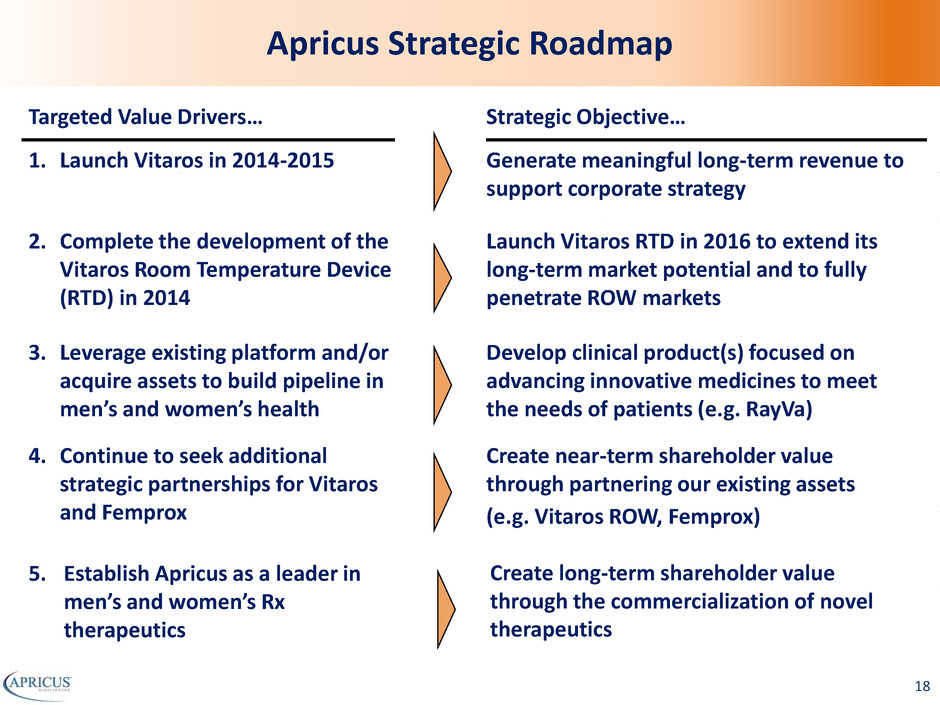
Apricus Strategic Roadmap Strategic Objective… Targeted Value Drivers… Launch Vitaros RTD in 2016 to extend its long-term market potential and to fully penetrate ROW markets 2. Complete the development of the Vitaros Room Temperature Device (RTD) in 2014 Generate meaningful long-term revenue to support corporate strategy 1. Launch Vitaros in 2014-2015 3. Leverage existing platform and/or acquire assets to build pipeline in men’s and women’s health Develop clinical product(s) focused on advancing innovative medicines to meet the needs of patients (e.g. RayVa) Create near-term shareholder value through partnering our existing assets (e.g. Vitaros ROW, Femprox) 4. Continue to seek additional strategic partnerships for Vitaros and Femprox Create long-term shareholder value through the commercialization of novel therapeutics 5. Establish Apricus as a leader in men’s and women’s Rx therapeutics 18
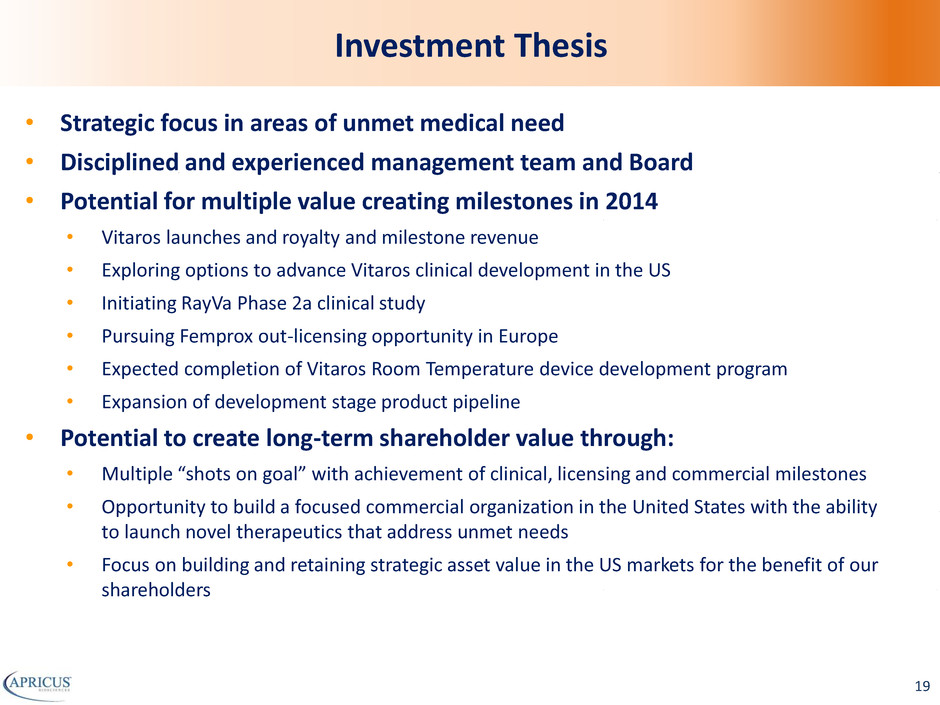
• Strategic focus in areas of unmet medical need • Disciplined and experienced management team and Board • Potential for multiple value creating milestones in 2014 • Vitaros launches and royalty and milestone revenue • Exploring options to advance Vitaros clinical development in the US • Initiating RayVa Phase 2a clinical study • Pursuing Femprox out-licensing opportunity in Europe • Expected completion of Vitaros Room Temperature device development program • Expansion of development stage product pipeline • Potential to create long-term shareholder value through: • Multiple “shots on goal” with achievement of clinical, licensing and commercial milestones • Opportunity to build a focused commercial organization in the United States with the ability to launch novel therapeutics that address unmet needs • Focus on building and retaining strategic asset value in the US markets for the benefit of our shareholders Investment Thesis 19
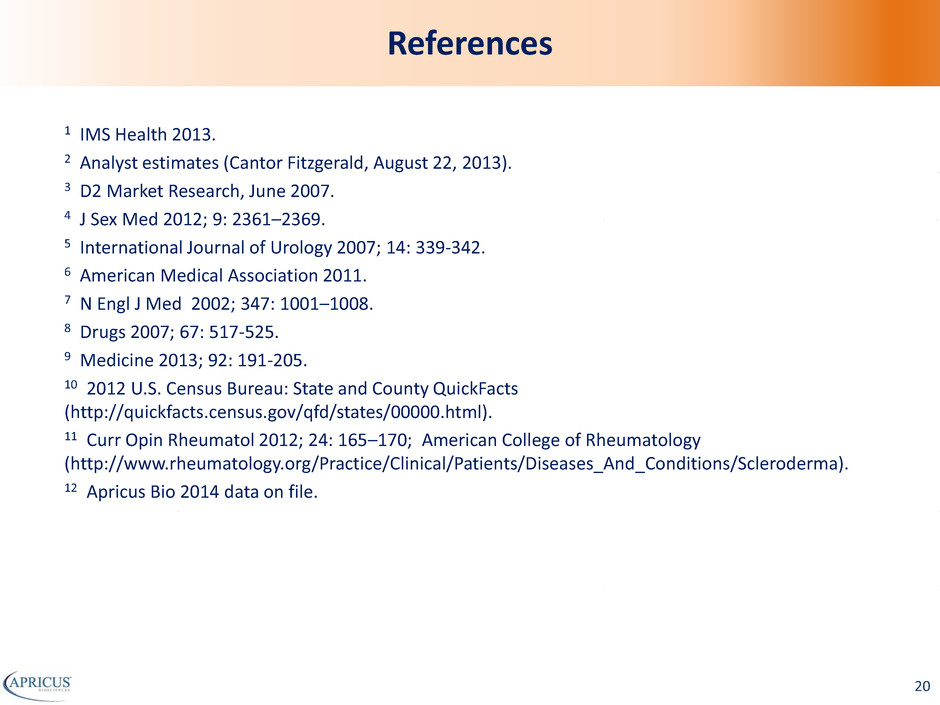
References 1 IMS Health 2013. 2 Analyst estimates (Cantor Fitzgerald, August 22, 2013). 3 D2 Market Research, June 2007. 4 J Sex Med 2012; 9: 2361–2369. 5 International Journal of Urology 2007; 14: 339-342. 6 American Medical Association 2011. 7 N Engl J Med 2002; 347: 1001–1008. 8 Drugs 2007; 67: 517-525. 9 Medicine 2013; 92: 191-205. 10 2012 U.S. Census Bureau: State and County QuickFacts (http://quickfacts.census.gov/qfd/states/00000.html). 11 Curr Opin Rheumatol 2012; 24: 165–170; American College of Rheumatology (http://www.rheumatology.org/Practice/Clinical/Patients/Diseases_And_Conditions/Scleroderma). 12 Apricus Bio 2014 data on file. 20
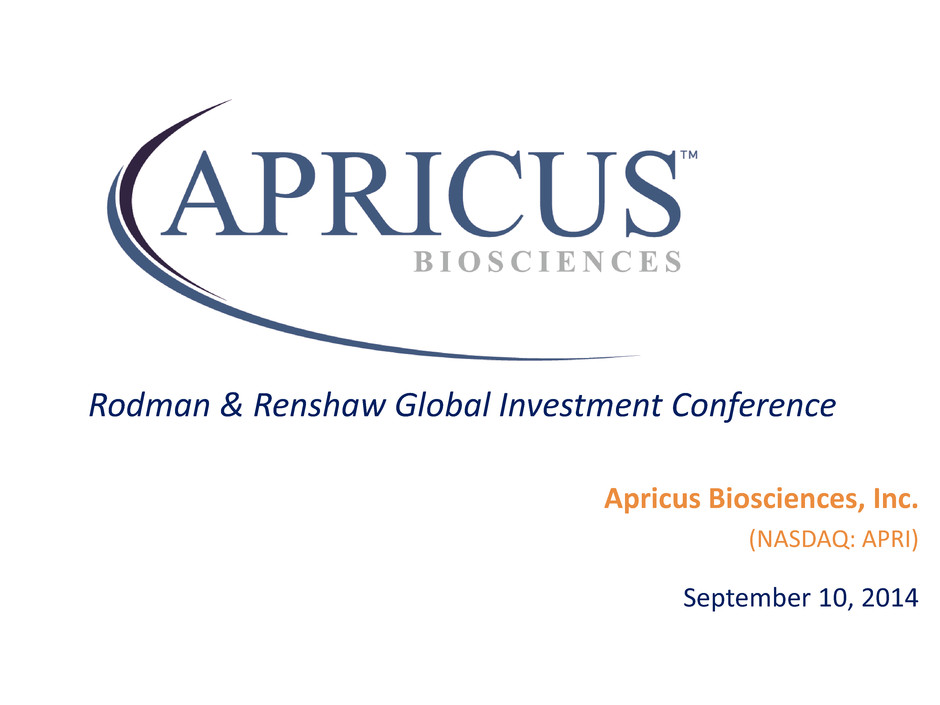
Rodman & Renshaw Global Investment Conference Apricus Biosciences, Inc. (NASDAQ: APRI) September 10, 2014
